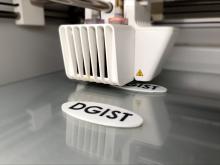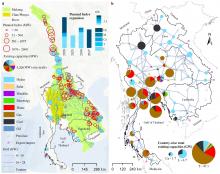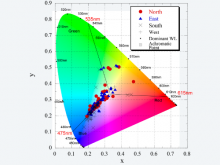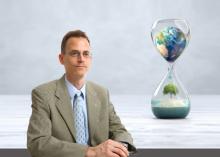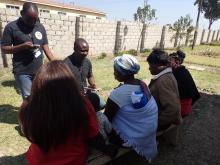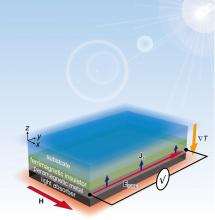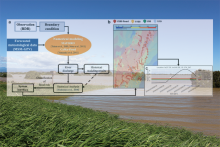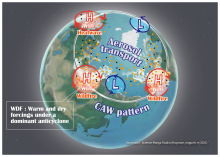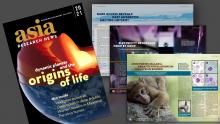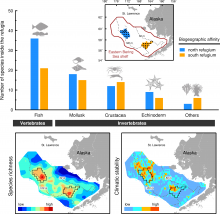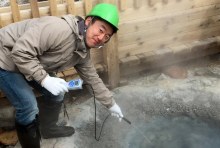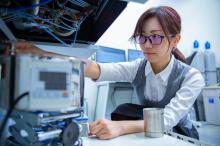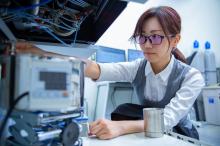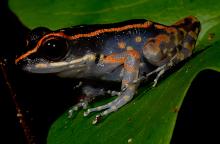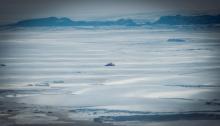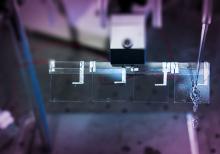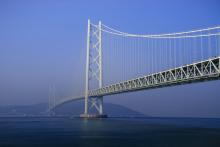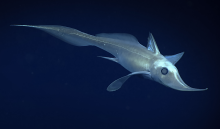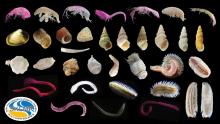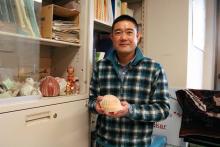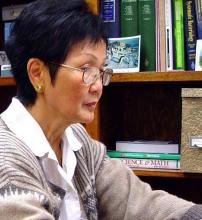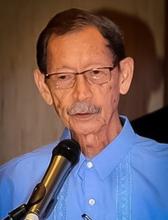Environment
News
18 Jul 2021
Using a CeO2 catalyst, researchers develop an effective catalytic process for the direct synthesis of polycarbonate diols without the need for dehydrating agents. The high yield, high selective process has CO2 blown at atmospheric pressure to evaporate excess water by-product allowing for a catalytic process that can be used with any substrate with a boiling point higher than water.
14 Jul 2021
Scientists develop a 3D-printed pressure sensor embedded with a temperature sensor from conductive carbon-based composites.
12 Jul 2021
Scientists in Singapore are calling for revisions in planned hydropower expansions in light of the rapidly decreasing cost of solar photovoltaic systems
09 Jul 2021
A new study monitored satellite images to obtain sea discoloration data as a novel indicator in detecting if an underwater volcano’s eruption is imminent.

08 Jul 2021
ARN's July newsletter features research about a promising treatment candidate to reverse dementia, a newly discovered climate pattern, using starch in tiny energy devices, exploring earth Earth ecosystems and the photo of the month.
05 Jul 2021
A team of leading climate social scientists, including a chair professor at The Education University of Hong Kong (EdUHK), argues that influential studies that attempt to quantify different countries’ “fair shares” of climate action have put forward a biased and oversimplified view of what is primarily a political and ethical discussion.
01 Jul 2021
Scientists show that an ocean-bottom seismometer deployed close to the calving front of a glacier in Greenland can detect continuous seismic radiation from a glacier sliding, reminiscent of a slow earthquake.
30 Jun 2021
Japanese and Zambian scientists have shown that environmental lead poisoning in children affects not only their own health and wellbeing, but the vitality and mental health of their mothers, as well.
29 Jun 2021
Magnetic layers interact with sunlight differently, creating a temperature gradient that generates electricity day and night.
18 Jun 2021
Researchers from The University of Tokyo Institute of Industrial Science develop a flood forecasting system that could help protect people and property during typhoons
15 Jun 2021
Paris, June 11 – Spending on science worldwide increased (+19%) between 2014 and 2018, as did the number of scientists (+13.7%). This trend has been further boosted by the COVID crisis, according to UNESCO’s new Science Report, The Race against Time for Smarter Development.

04 Jun 2021
ARN's June newsletter features research on a hands-off approach to discipline, better robot hand design, nucleosomes and marine biodiversity, plus the latest Beyond the Journal and a feature from the ARN magazine.
03 Jun 2021
Research Covers Humans’ Historical Adaptation to Climate Change
02 Jun 2021
Scientists have uncovered a summertime climate pattern in and around the Arctic that could drive co-occurrences of European heatwaves and large-scale wildfires with air pollution over Siberia and subpolar North America.
31 May 2021
Scientists have shown that the population of the Yakushima sika deer has declined due to natural factors, suggesting that the population can be regulated without culling.
25 May 2021
Researchers at The University of Tokyo Institute of Industrial Science repurpose food waste to build materials with a bending strength comparable to concrete and that still taste good
18 May 2021
The Asia Research News magazine brings you fascinating research stories from diverse voices in environment, technology, materials, medicine, space and social sciences. The 2021 edition is out now.
17 May 2021
Scientists from Hokkaido University have used species survey and climate data to identify two marine biodiversity refugia in the Eastern Bering Sea – regions where species richness, community stability and climate stability are high.
12 May 2021
From biomemory to implants, researchers are looking for ways to make more eco-friendly electronic components.
12 May 2021
Invented by Professor Ho Wing-kei at the Department of Science and Environmental Studies of The Education University of Hong Kong (EdUHK), the novel graphitic carbon nitride photocatalyst provides an innovative way for environmental purification. Compared to the traditional photocatalyst such as titanium dioxide, which can only be activated by UV light, and has a relatively low effectiveness in air pollutant degradation, the newly developed photocatalyst can utilise visible light (daylight or indoor light) as the light source for photocatalytic reactions.
11 May 2021
Tomohiro Mochizuki tracks down viruses inside single-cell organisms thriving in boiling hot springs. His fieldwork is conducted in relatively extreme environments and, despite the significance of his investigations, he doesn’t need many fancy gadgets back at his lab at Japan’s Earth-Life Science Institute (ELSI). ARN asked Mochizuki about his virus-hunting exploits and what they involve.
11 May 2021
“By looking at substances in volcanos, lakes and hotsprings, you can start to see the ecosystems that existed billions of years ago,” says Mayuko Nakagawa, a microbiologist and specially-appointed assistant professor at the Earth-Life Science Institute (ELSI) based at the Tokyo Institute of Technology, Japan. She analyses components left by microorganisms with colleagues from various disciplines, while as a lab manager, she looks after cutting-edge equipment and visitors from different countries.
11 May 2021
火山や湖、温泉の物質からは数十億年前に存在した微生物の生態系が見えてくると語るのは、東京工業大学・地球生命研究所(ELSI)の中川麻悠子特任助教。異分野の研究者たちと共に微生物の作り出した成分を解析する傍ら、ラボマネージャーとして国内外の訪問者サポートや最先端の機材の管理などを行っている。
10 May 2021
A new study on frogs shows gene flow and population structure should be considered to determine if morphologically similar and genetically distinct animals comprise separate species.
10 May 2021
Ice is melting at a surprisingly fast rate underneath Shirase Glacier Tongue in East Antarctica due to the continuing influx of warm seawater into the Lützow-Holm Bay.
10 May 2021
A new device can light up 100 LED bulbs with a single drop of water.
10 May 2021
Complex algorithms can be taught to predict steel corrosion rates in coastal regions, helping engineers choose the best materials for each location.
10 May 2021
Deep sea animals face greater risks compared to those nearer the surface as they become less able to maintain their preferred thermal habitats with climate change.
05 May 2021
Biodiversity is of crucial importance to the marine ecosystem. The prohibition of trawling activities in the Hong Kong marine environment for two and a half years has significantly improved biodiversity, an inter-university study led by City University of Hong Kong (CityU) has found. Research results showed that the trawl ban could restore and conserve biodiversity in tropical coastal waters.
05 Apr 2021
“The earth is suffering from several ‘diseases’: global warming, ocean acidification, habitat loss, etc. If any of these diseases remains uncured, other diseases will accelerate and cause new ones to appear, hence putting humanity’s well-being in danger,” said Associate Professor Masahiko Fujii. For this reason, the research staff of the Faculty of Environmental Earth Science keeps on assessing the current global environmental issues and promoting renewable energy sources as a possible solution.
Events
Sorry, no events coming up for this topic.
Researchers
Sorry, no researchers coming up for this topic.
- « first
- ‹ previous
- 1
- 2
- 3
Giants in history
Tetsuya Theodore Fujita (23 October 1920 – 19 November 1998) was a Japanese-American meteorologist who created the Fujita scale that classifies the strength of tornadoes based on damage to structures and vegetation.
Archana Sharma (16 February 1932 - 14 January 2008) conducted research into plant and human genetics that expanded the understanding of both botany and human health. In relation to botany, she uncovered the means by which asexually-reproducing plants evolve into new species.
Roseli Ocampo-Friedmann (23 November 1937 – 4 September 2005) was a Filipino-American scientist whose research focused on cyanobacteria and microorganisms that inhabit extreme environments.
Edgardo Dizon Gomez (7 November 1938 – 1 December 2019) was a Filipino marine biologist who recognized the need to protect marine resources, especially coral reefs, in the Philippines.
Anna Mani (23 August 1918 – 16 August 2001) was an Indian meteorologist who contributed significantly to the understanding of solar radiation, ozone and wind energy by developing a wide range of measurement tools. One of India’s pioneering female scientists, Mani excelled in the male-dominated area of meteorology and became the Deputy Director-General of the India Meteorological Department.
Võ Quý (1929 – 2017) was a Vietnamese ornithologist who studied the destruction of tropical forests and agricultural lands in Vietnam by Agent Orange, a herbicide used by the U.S. military during the Vietnam War. In addition to planning forest restoration projects, Quý rediscovered the rare eastern sarus crane, an endangered species that had vanished during the war.
Japanese geochemist Katsuko Saruhashi developed the first method and tools for measuring carbon dioxide in seawater



